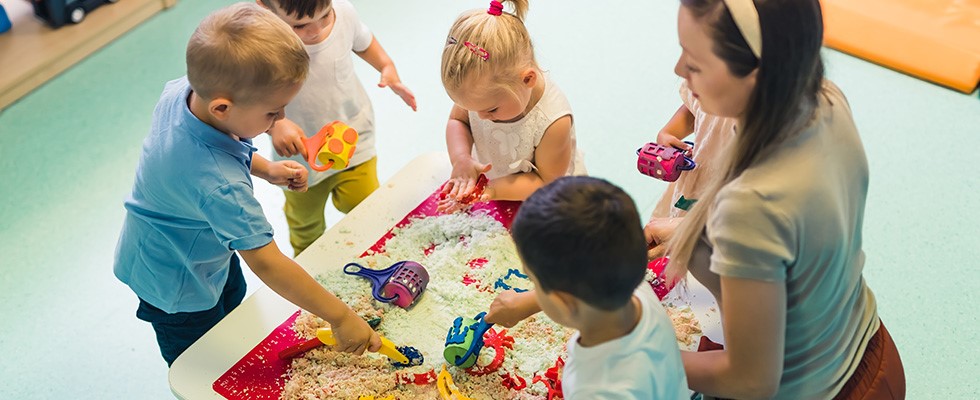
It’s the New Year, and for educators and school administrators, it’s time to start planning 2024-2025 classroom updates and designs. As part of your design and furniture wish list, you might be interested in finding new and innovative ways to adapt to the needs and preferences of your neurodivergent students.
Neurodivergent students often require unique spaces and sensory tools to facilitate positive experiences and learning, making it a challenge for teachers with limited space and resources to meet their needs. But creating a sensory- friendly classroom doesn’t have to be hard – or expensive.
For example, we found a story about two educators who used $250 to create an inflatable ball pit for their neurodiverse students. It became a genius resource for kids looking to release stress or a little pent-up energy before returning to formal instruction.
Of course, a ball pit may not be right for everyone. But the story inspired us to take a deep dive into what sensory space trends are around the corner in 2024.
Today, we’re sharing what you need to know about sensory spaces – and how making even small changes to your classroom to embrace your neurodiverse students can facilitate better learning for everyone.
Start by understanding your students’ sensory needs
Before you decide what improvements to bring to your classroom, it’s best to have a proper understanding of your neurodivergent students’ needs. Begin with the parents. The CDC estimates that one in 36 families are directly affected by Autism Spectrum Disorders (ASD.) And there are other neurodivergent conditions and characteristics to consider, including Dyslexia, Attention Deficit Hyperactivity Disorder (ADHA,) and other cognitive function conditions.
The parents of your neurodivergent students can often provide the relevant details you need to develop a plan for improving their experiences in your learning space.
As a teacher, you don’t have to be a neuroscientist to improve how your neurodivergent students learn. You can enhance their learning experiences now by incorporating sensory tools into their everyday routine.
Tactile sensory, visual sensory, auditory sensory, and other sensory tools can be just the small touches your classroom needs to make a big impact.
Consider room designs and furniture that support:
Positive behavior. Wobble stools, for example, promote a healthy release of energy.
Visual learning. Creative marker boards display assignments for students who benefit from visual reminders.
Calming exercises. Quiet nooks, for example, encourage those who need a break from the bustle of class to refocus.
Healthy movement. Swivel chairs at desks channel fidgeting energy in a healthy way that doesn’t disrupt others.
Prioritize sensory safety
Another emerging trend in classrooms, especially among those schools preparing for new room designs in 2024, is safety. Because it’s often difficult to identify every neurodivergent condition or sensory learning preference, schools are moving forward with improvements that are rooted in classroom and student safety.
Focus on protecting the students from themselves or others with designs that prioritize safe learning spaces and experiences.
Consider adopting new designs and learning space enhancements that promote:
Safe physical spaces, like a calming corner, for those experiencing anxiety, sadness, or stress.
Safe mental health practices and routines students can rely on for stability, yet still be flexible with learning methods that address individual needs.
Safe social experiences that allow educators to normalize unique sensory needs without singling out special needs students.
Sensory space challenges and solutions
It’s challenging for educators to make changes to their learning spaces that meet the needs of all their students, not just their neurotypical ones. Additionally, funding and compliance regulations can make it tough to make over-arching enhancements all at once.
The solution – and we’re seeing countless schools adopting this approach – is to incorporate smaller, manageable updates to classroom designs and furniture. Working with what you have, much like those two educators did with their ball pit and $250, can still be significantly beneficial for your students.
Incremental sensory enhancements, as the Child Mind Institute suggests, can benefit both your neurodivergent and neurotypical students and might include:
Soft seating that’s ideal for a relaxation area
Active stools as healthy channels for expelling energy
Dry erase lapboards perfect for individual work
Study carrels that offer students solitude and personal space
Reading nooks to quiet and focus overstimulated students
Sensory tables with STEM activities that are inviting for everyone
School Outfitters has the sensory space expertise you need
While planning for the New Year, consider these emerging trends and small-step- big-improvement ideas to make your learning spaces conducive to neurodivergent students. Maybe you don’t opt for the ball pit. But you can start by exploring our special education and inclusion products.
Our experts can help you find just the right products for your space – products that fit your budget and your timeline.
Have questions? We're here to help! Our experts are available by phone at 1-800-260-2776. You can also get personalized assistance through our or by emailing us. We're available Monday-Friday, 8am-7pm.


